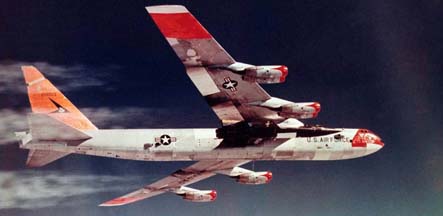 More information about the history of the X-15
program can be found on the X-15 Forty Years
Later pages.
More information about the history of the X-15
program can be found on the X-15 Forty Years
Later pages.
There is a venerable bird flying at the NASA Dryden Flight Research Center at Edwards AFB. The oldest flying B-52 is currently engaged in the testing of the Space Station Crew Return Vehicle demonstrator, the X-38, and will soon be launching the unmanned, air-breathing, Mach-8 Hyper-X, mounted on the nose of a Pegasus satellite launcher. In its long career, it has launched the three X-15 hypersonic rocket planes, the HL-10, M2-F2/F3, X-24A/B lifting bodies, the space shuttle booster parachute recovery system testbed, a 3/8 scale F-15 remotely piloted research vehicle (RPRV), the High Maneuverability Aircraft Technology (HiMAT) RPRV, the Pegasus satellite launcher, and tested the drogue chute currently used on the space shuttle orbiters.
These photos were taken by other Edwards AFB aficionados, including my father, Richard Lockett and a college professor of mine, Earl Hajic.
 More information about the history of the X-15
program can be found on the X-15 Forty Years
Later pages.
More information about the history of the X-15
program can be found on the X-15 Forty Years
Later pages.
(Download a higher resolution picture by clicking on any
picture below.) 
By the time the X-15 was developed in the latter half of the fifties, the air launching of high speed rocket propelled research vehicles had become standard practice.
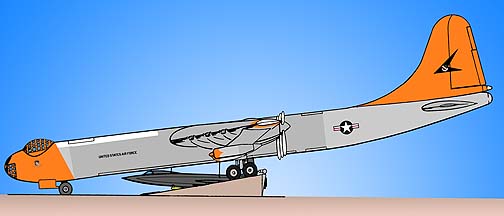 Initially the intent was to
procure a surplus B-36 Peacemaker and mount the X-15 in the bomb
bay as the X-1 and X-2 vehicles had been mounted in B-29 and B-50
Superfortresses. The B-36 would have been pulled up onto a pair of ramps with winches. The X-15 would have been rolled underneath the B-36 on its handling dolly and then lifted aboard the B-36 with cables. Line drawing courtesy AFFTC/HO. Colorization: Brian Lockett.
Initially the intent was to
procure a surplus B-36 Peacemaker and mount the X-15 in the bomb
bay as the X-1 and X-2 vehicles had been mounted in B-29 and B-50
Superfortresses. The B-36 would have been pulled up onto a pair of ramps with winches. The X-15 would have been rolled underneath the B-36 on its handling dolly and then lifted aboard the B-36 with cables. Line drawing courtesy AFFTC/HO. Colorization: Brian Lockett.
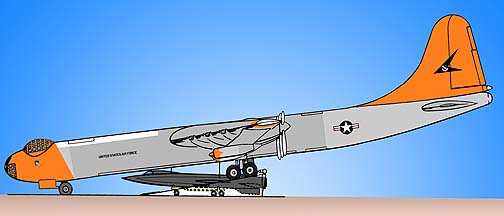 The loading ramp has been rendered in cutaway to reveal the X-15 and its handling dolly.
Line drawing courtesy AFFTC/HO. Colorization: Brian Lockett.
The loading ramp has been rendered in cutaway to reveal the X-15 and its handling dolly.
Line drawing courtesy AFFTC/HO. Colorization: Brian Lockett.
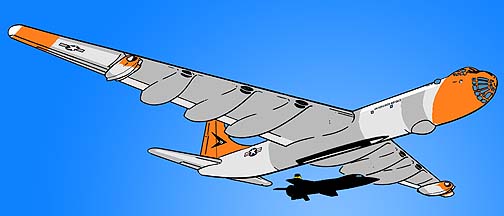 The B-36 would have launched the X-15 at an altitude of 35,000 feet and a speed of Mach 0.7. Line drawing courtesy AFFTC/HO. Colorization: Brian Lockett.
The B-36 would have launched the X-15 at an altitude of 35,000 feet and a speed of Mach 0.7. Line drawing courtesy AFFTC/HO. Colorization: Brian Lockett.
In mid-1957, NASA directed North American Aviation to change the mother plane from the B-36 Peacemaker to the B-52 Stratofortress. It had been realized that the B-36 was going to be phased out of service at about the time that the X-15 began flying. Spare parts would become difficult to come by and the prospect of maintaining a single Peacemaker long after the type had been retired was daunting.
When early production B-52s had completed their initial service tests and became available for other uses, the benefits of using a Stratofortress were quickly realized. The third B-52A and the fifth B-52B were sent to North American for modification as launch aircraft for the X-15 program.
Modifications to the two aircraft were made at Plant 42 in Palmdale. The B-52A, serial 52-0003, arrived at Plant 42 from Boeing on November 29, 1957 and was moved into the North American hangar for the beginning of modifications on February 4, 1958. The B-52B, serial 52-0008, arrived on December 13, 1958 and was moved into the North American hangar on January 6, 1959.
The modifications included a pylon under the starboard wing, inboard of the engine nacelles and capable of carrying 50,000 pounds. The pylon provided three shackles for the support of the X-15 and umbilical attachments for Liquid Oxygen, nitrogen, breathing oxygen and electrical power. The No. 3 main fuel tank located in the wing above the pylon was removed.
To accommodate the vertical stabilizer of the X-15, a notch was cut into the trailing edge of the starboard wing directly behind the X-15 pylon. The inboard flaps were disabled, but the outer flaps remained functional. A 1,500 gallon liquid oxygen tank was installed in the bomb bay of each B-52 to refill the X-15's tanks as the volatile fluid boiled away while the X-15 was being carried to the launch altitude of 45,000 feet. Closed circuit television, film motion picture cameras, and lights were installed on the starboard side of the fuselage. Tail gun turrets and tip tanks were removed.
A launch panel was installed on the upper deck of the B-52, at which the operator could monitor the fueling and other services of the X-15. Through the launch panel, altitude and velocity data were fed into the X-15 inertial guidance computer until launch. The launch panel operator watched for the liquid oxygen top-off overflow and checked the function of the X-15 flight control surfaces. Later in the program, a plexiglas dome was mounted on the upper deck of each B-52 for direct observation of the X-15 by the launch panel operator. The release system for the X-15 was installed for operation by the pilot of the B-52.
A panel of five launch indicator lights was installed to coordinate the pilots of the B-52 and X-15. Three lights confirmed the pylon hooks have securely engaged the X-15. The "ready to launch" light and the "launch" light were operated by switches in the cockpit of the X-15 to indicate, first, that the its systems had been configured for launch and, second, that the X-15 pilot was ready to begin the launch countdown. This was installed as a precaution after a couple of incidents in earlier rocket programs when pilots had been inadvertently launched after they had tried to abort the mission.
The modifications were tested by Captains Charles Bock and John Allavie with W. Berkowitz of North American at the launch panel. Initially, airspeed was limited to 500 miles per hour with the X-15 attached.
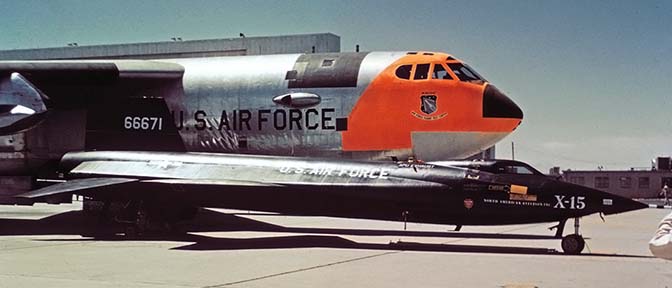 North American X-15-2 56-6671 made its first public appearance next to Boeing NB-52A Stratofortress 52-0003. The NB-52A was the fifth B-52 built and was retired in 1969. It can now be seen at the Pima Air Museum near Tuscon, Arizona.Link to the history of the NB-52A Stratofortresses used to launch the X-15s and a variety of other research vehicles. Go to more photos of the 1959 Edwards AFB Airshow. Photo by Richard Lockett Sr.
North American X-15-2 56-6671 made its first public appearance next to Boeing NB-52A Stratofortress 52-0003. The NB-52A was the fifth B-52 built and was retired in 1969. It can now be seen at the Pima Air Museum near Tuscon, Arizona.Link to the history of the NB-52A Stratofortresses used to launch the X-15s and a variety of other research vehicles. Go to more photos of the 1959 Edwards AFB Airshow. Photo by Richard Lockett Sr.
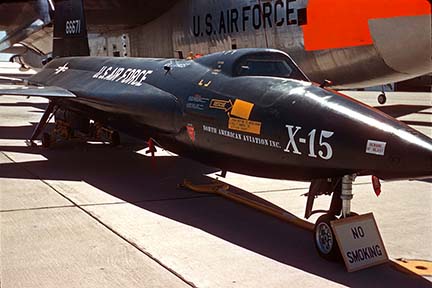 North American X-15-2 56-6671 and Boeing NB-52A Stratofortress 52-0003.
North American X-15-2 56-6671 and Boeing NB-52A Stratofortress 52-0003.
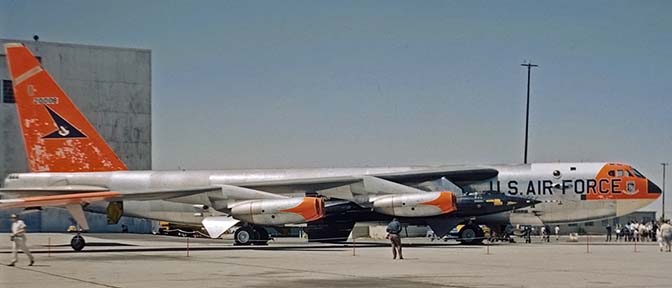 NB-52B 52-0008 with the X-15-1 56-6670 at the 1960
Edwards AFB Open House on May 17. Joe Walker had made the first
mach 3 X-15 flight in it on May 12. He reached mach 3.11 (2111
miles per hour) and an altitude of 77,882 feet, breaking Mel
Apt's speed record of mach 3.196 (2094 miles per hour), set in
the X-2 on September 27, 1956. Photo by Richard Lockett Sr.
NB-52B 52-0008 with the X-15-1 56-6670 at the 1960
Edwards AFB Open House on May 17. Joe Walker had made the first
mach 3 X-15 flight in it on May 12. He reached mach 3.11 (2111
miles per hour) and an altitude of 77,882 feet, breaking Mel
Apt's speed record of mach 3.196 (2094 miles per hour), set in
the X-2 on September 27, 1956. Photo by Richard Lockett Sr.
Two days after the airshow, the X-15-1 would be flown by Major Robert White to a speed of mach 2.31 (1590 miles per hour) and an altitude of 108,997 feet, an altitude only previously exceeded by Ivan Kinchloe in the X-2 on September 7, 1956.
The orange dayglo paint on the tail can be seen to be peeling and within a short time it was removed, along with the dayglo on the engine intakes. Dayglo was used extensively on the aircraft operated from Edwards AFB in that era because orange wreckage is much easier to spot in the desert than aluminum, which tends to mirror the color of its surroundings. Go to more photos of the 1960 Edwards AFB Airshow.
The X-15 #2, serial 56-6671, 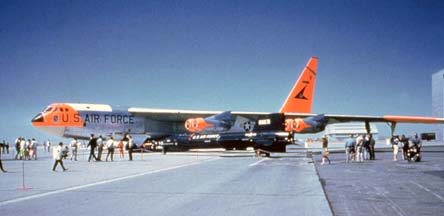 was on display on the left side of
the NB-52B at the 1960 Edwards
AFB Open House. Photo by W. Duncan via Dave Menard and Greg
Spahr.
was on display on the left side of
the NB-52B at the 1960 Edwards
AFB Open House. Photo by W. Duncan via Dave Menard and Greg
Spahr.
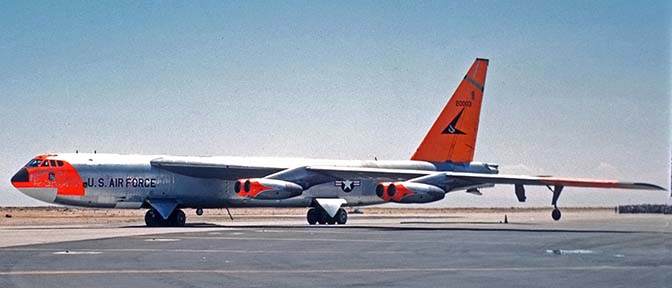 The NB-52A 52-0003 taxis along the flightline at the 1960 Edwards
AFB Open House. The NB-52A carried the name "The High and
Mighty One" and nose art depicting an eagle dropping an X-15
from its talons. Photo by Richard Lockett Sr.
The NB-52A 52-0003 taxis along the flightline at the 1960 Edwards
AFB Open House. The NB-52A carried the name "The High and
Mighty One" and nose art depicting an eagle dropping an X-15
from its talons. Photo by Richard Lockett Sr.
 Boeing NB-52A Stratofortress 52-003.
Boeing NB-52A Stratofortress 52-003.
The 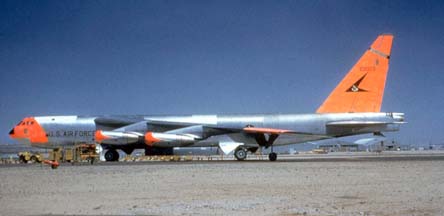 NB-52A
photographed in 1960 Photo by William Jeffries via Dave Menard
and Greg Spahr.
NB-52A
photographed in 1960 Photo by William Jeffries via Dave Menard
and Greg Spahr.
 The dayglo had been stripped from the engine
inlets and tail of the NB-52A
when this picture was taken at the 1962 Edwards AFB Open House.
Major Allavie and Captain Campbell would drop Major Bob Rushworth
in the X-15-1 on its twenty-eighth flight on May 22. Using the
50,000 pound thrust XLR-99 rocket engine, the X-15 would reach
mach 5.03 (3450 miles per hour) and 100,400 feet altitude on that
flight. Photo by Tom Brewer via Greg Spahr.
The dayglo had been stripped from the engine
inlets and tail of the NB-52A
when this picture was taken at the 1962 Edwards AFB Open House.
Major Allavie and Captain Campbell would drop Major Bob Rushworth
in the X-15-1 on its twenty-eighth flight on May 22. Using the
50,000 pound thrust XLR-99 rocket engine, the X-15 would reach
mach 5.03 (3450 miles per hour) and 100,400 feet altitude on that
flight. Photo by Tom Brewer via Greg Spahr.
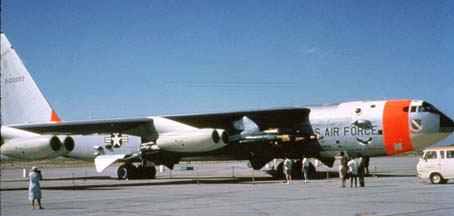 The NB-52A
was displayed at the May 16, 1965 Edwards AFB Open House with an
X-15. The NB-52A had recently returned from modifications at
Boeing in Wichita, Kansas. All three X-15s would launched from
the NB-52B before the next launch from the NB-52A occurred on
June 16. Lt. Colonel Fitzhugh Fulton (Link: NASA Dryden Biography) and Squadron
Leader Cratney would launch Captain Joe Engle on the X-15 #3's
forty-third flight. Engle would attain mach 4.69 (3404 miles per
hour) and an altitude of 244,700 feet.. Photo by Tom Brewer via
Greg Spahr.
The NB-52A
was displayed at the May 16, 1965 Edwards AFB Open House with an
X-15. The NB-52A had recently returned from modifications at
Boeing in Wichita, Kansas. All three X-15s would launched from
the NB-52B before the next launch from the NB-52A occurred on
June 16. Lt. Colonel Fitzhugh Fulton (Link: NASA Dryden Biography) and Squadron
Leader Cratney would launch Captain Joe Engle on the X-15 #3's
forty-third flight. Engle would attain mach 4.69 (3404 miles per
hour) and an altitude of 244,700 feet.. Photo by Tom Brewer via
Greg Spahr.
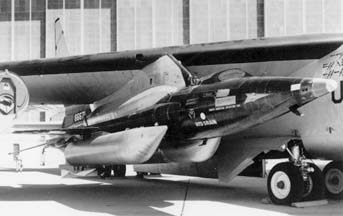 The X-15#2 was involved in a
serious accident on its thirty-first flight on November 9, 1962.
While it was being repaired, the opportunity was taken to modify
it for even higher speeds and it was redesignated as the X-15A-2. The most notable
modification was the addition of large external fuel and oxidizer
tanks. The fuselage was stretched by twenty-nine inches. The
windshield was replaced with smaller oval windows to reduce the
potential for cracking that had been displayed by the original.
It is seen here mounted on the NB-52B on the flightline at
Edwards AFB in late 1965 or 1966. Photo courtesy North American
Rockwell.
The X-15#2 was involved in a
serious accident on its thirty-first flight on November 9, 1962.
While it was being repaired, the opportunity was taken to modify
it for even higher speeds and it was redesignated as the X-15A-2. The most notable
modification was the addition of large external fuel and oxidizer
tanks. The fuselage was stretched by twenty-nine inches. The
windshield was replaced with smaller oval windows to reduce the
potential for cracking that had been displayed by the original.
It is seen here mounted on the NB-52B on the flightline at
Edwards AFB in late 1965 or 1966. Photo courtesy North American
Rockwell.
 The NB-52B
on static display at the May 21, 1967 Edwards AFB Open House with
the X-15-1. Two weeks earlier, on May 8, the NB-52B had launched
Bruce Peterson (Link: NASA Dryden Biography) at the controls of
the sixteenth glide flight of the M2-F2. Roll instability and a
rescue helicopter in Peterson's flight path caused him to land
before the landing gear had fully extended, resulting in a
spectacular rolling, flipping crash. Bruce Peterson was badly
injured in the accident, film of which was used in the opening
sequence of "The Six Million Dollar Man" television
series. Photo by Paul Minert via Greg Spahr.
The NB-52B
on static display at the May 21, 1967 Edwards AFB Open House with
the X-15-1. Two weeks earlier, on May 8, the NB-52B had launched
Bruce Peterson (Link: NASA Dryden Biography) at the controls of
the sixteenth glide flight of the M2-F2. Roll instability and a
rescue helicopter in Peterson's flight path caused him to land
before the landing gear had fully extended, resulting in a
spectacular rolling, flipping crash. Bruce Peterson was badly
injured in the accident, film of which was used in the opening
sequence of "The Six Million Dollar Man" television
series. Photo by Paul Minert via Greg Spahr.
The X-15-1's next flight was its seventy-second flight on June 15. Colonel Cotton and Major Reschke would launch Mike Adams from the NB-52A on a flight that would attain mach 5.44 (3693 miles per hour) and an altitude of 229,300 feet.
The next launch conducted by the NB-52B would be the sixtieth flight of the X-15 #3, serial 56-6672, on June 22. Lt. Colonel Sturmthal and Colonel Cotton would launch Bill Dana (Link: NASA Dryden Biography) on a flight to mach 5.44 (3611 miles per hour) and an altitude of 82,200 feet.
The X-15A-2, piloted by
Pete Knight 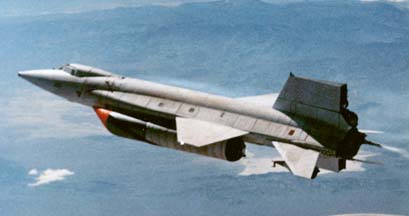 , shortly after launch on mission
2-53-97. It had been launched from the NB-52B by Colonel Cotton
and Major Reschke over Mud Lake in Nevada at an altitude of
45,000 feet. On this flight it achieved the highest speed of any
manned aircraft except the space shuttle, mach 6.70 (4520 miles
per hour). It flew nearly directly over Racetrack Playa in Death
Valley National Monument at about 100,000 feet going mach 6. If
you had been in Death Valley on that october morning, the rocket
plume of the hypersonic spaceplane would have been clearly
visible as it streaked across the sky, twice as fast as an SR-71A
Blackbird. Shortly afterward, the sonic boom would have echoed
back and forth within the valley walls. (Photo courtesy Edwards
Air Force Base History Office)
, shortly after launch on mission
2-53-97. It had been launched from the NB-52B by Colonel Cotton
and Major Reschke over Mud Lake in Nevada at an altitude of
45,000 feet. On this flight it achieved the highest speed of any
manned aircraft except the space shuttle, mach 6.70 (4520 miles
per hour). It flew nearly directly over Racetrack Playa in Death
Valley National Monument at about 100,000 feet going mach 6. If
you had been in Death Valley on that october morning, the rocket
plume of the hypersonic spaceplane would have been clearly
visible as it streaked across the sky, twice as fast as an SR-71A
Blackbird. Shortly afterward, the sonic boom would have echoed
back and forth within the valley walls. (Photo courtesy Edwards
Air Force Base History Office)
As the X-15A-2 crossed Death Valley, shock waves streaming from the supersonic combustion ramjet aerodynamic test shape mounted on the ventral stabilizer superimposed themselves in unexpected ways, creating hot spots at the intersections of the waves. Higher temperatures on the ventral fin were encountered than had been predicted. Holes were burnt through the nickel-iron skin and plasma flowed into the stabilizer and the rear fuselage of the X-15A-2 causing significant damage to the plumbing and wiring within.
The X-15A-2 was subsequently repaired, but it never flew again.
Mike Adams' seventh flight in the X-15 was the one hundred ninety-first flight of the program. He flew the third X-15, serial 56-6672, which had been equipped with the MH-96 flight control system that automatically blended the aerodynamic flight controls with the hydrogen peroxide fueled reaction control thrusters as the X-15 transitioned from the atmosphere to the vacuum of space and then re-entered the atmosphere.
Mike Adams is seen here standing in front of the modified X-15A-2, serial 56-6671, in the NASA Flight Research Center Hangar at Edwards Air Force Base. (Photo courtesy North American Rockwell)
The X-15 carried seven experiments; a boost guidance experiment, a solar spectrum measurement, an ultraviolet rocket exhaust plume detector, a micrometeorite collector, a tip pod deflection camera, Saturn rocket booster ablative thermal protection material, and a "traversing probe" for measuring the shock wave in front of the wing tip pod. These experiments added to the workload of the X-15 pilot. The solar spectrum measurement required the pilot to extend it from the q-bay behind the cockpit and then retract it again. The ultraviolet plume detector would observe the X-15 rocket exhaust plume against black space and then against the earth as a background which required the X-15 to be rolled from side-to-side,
Mike Adams was launched at 10:30 in the morning in the X-15 #3, over Delamar Dry Lake in Nevada from the modified NB-52B, serial 52-0008, at an altitude of 45,000 feet. He fired the 55,000 pound thrust XLR-99 rocket engine and accelerated for 82 seconds to over mach 5. After the fuel was expended the X-15 continued on a ballistic trajectory to 266,000 feet, three minutes after launch.
An electrical disturbance from the traversing probe experiment caused the automatic reaction control thrusters to shut down. It also caused errors in the presentation of the attitude of the X-15 on the cockpit displays. The thrusters should have kept the X-15 aligned with its flight path. Their deactivation allowed the nose of the spaceplane to swing to one side as it reached its peak altitude.
Twice during the ascent, the inertial computer system failure lights came on. Then an electrical disturbance disengaged the pitch and roll stability dampers. Five seconds later the dampers reengaged.
As he started to descend, Adams began to use the manual reaction controls. It is believed that he was suffering from vertigo, a loss of spatial orientation. His control inputs were in the wrong direction and made the X-15 swing even farther around. The X-15 spun completely around at 3,500 miles per hour as it re-entered the atmosphere over Cuddeback Lake near the gold mining town of Randsburg in California.
As the X-15 descended through 120,000 feet, the X-15 recovered from the spin, but at that point the adaptive flight control system overcontrolled the elevators, commanding them to move faster than the actuators could move them. This drove the X-15 into violent pitch and roll oscillations. Mike Adams was tossed up and down inside the cockpit of the X-15 with thirteen times the force of gravity, both ways. He was unable to initiate the ejection sequence. The g-load on the X-15 caused its nickel-steel structure to break into many pieces at about 60,000 feet.
Mike Adams was killed when the cockpit section of the X-15 hit the ground near the town of Johannesburg in the Mojave Desert, five minutes and fifty seconds after he had been launched from the NB-52B. He was posthumously awarded astronaut's wings.
The loss of Mike Adams is not often enough noted in the recounting of the story of the conquest of space.
The X-15 #3 rides under the wing of the NB-52B, serial 52-0008, prior to launch in early 1967. (Photo courtesy Edwards Air Force Base History Office)
The full story of the X-15 program is found in Milton Thompson's book, At the Edge of Space: The X-15 Flight Program, which was the source of the information found on this page.
The last X-15 launch from the NB-52B was the seventy-seventh flight of the X-15-1 on May 11, 1968. Bill Dana was launched by Lt. Colonel Reschke and Colonel Cotton.
The last X-15 flight was made by Bill Dana in the X-15-1 on October 24, 1968. The X-15 reached mach 5.38 (3716 miles per hour) and an altitude of 255,000 feet. He was launched by Lt. Colonel Sturmthal and Squadron Leader Miller from the NB-52A. It was the eighty-first flight of the X-15-1 and the one hundred-ninety-ninth flight of the program. The NB-52A made one more captive carry of the X-15-1 on December 12, but that flight was aborted.
The maximum speed attained during the X-15 program was mach 6.70 (4520 miles per hour) on the fifty-third and last flight of the X-15A-2 on October 3, 1967 with Captain Pete Knight at the controls. He had been launched from the NB-52B by Colonel Cotton and Major Reschke.
The maximum altitude of the program was 354,200 feet, achieved during the twenty-second flight of the X-15 #3. Joe Walker flew that X-15 flight after being launched by Major Bement and Lt. Colonel Lewis from the NB-52A on August 22, 1963.
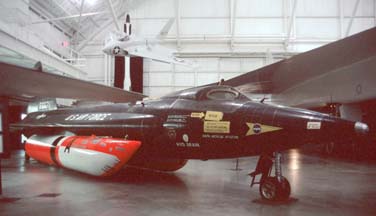 The North American X-15A-2, serial 56-6671, is displayed
at the Air Force Museum. It is seen here on August 16, 1998. Its
markings have been restored and it has been fitted with its
external propellant tanks. They are painted as they appeared on
the first flight of the X-15A-2 with the tanks mounted. That
flight occurred on November 3, 1965.
The North American X-15A-2, serial 56-6671, is displayed
at the Air Force Museum. It is seen here on August 16, 1998. Its
markings have been restored and it has been fitted with its
external propellant tanks. They are painted as they appeared on
the first flight of the X-15A-2 with the tanks mounted. That
flight occurred on November 3, 1965.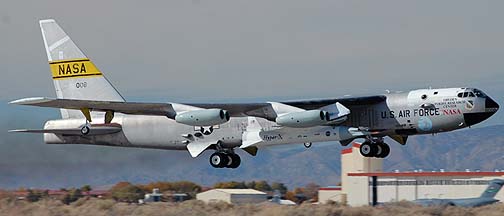 Boeing NB-52B
Stratofortress Mothership.
Boeing NB-52B
Stratofortress Mothership.
eBook edition of Balls Eight: History of the Boeing NB-52B Stratofortress Mothership |
||
|
My book Balls Eight: History of the Boeing NB-52B Stratofortress Mothership is now available as an eBook for just $10.99, a considerably reduced price compared to the print edition. It has been asserted that the Boeing NB-52B Stratofortress, carrying Air Force serial 52-0008, can lay claim to being the airplane that has seen and participated in more history than any other single airplane. For forty-five years, the NB-52B was a fixture at Edwards Air Force Base. While the NB-52B is most famous for launching the three North American X-15 rocket planes, it continued to serve in the role of launch platform for a multitude of programs until its final mission, launching the Mach-10 X-43A Hyper-X, on November 16, 2004. It was the oldest flying B-52 by nearly ten years. The eBook edition is profusely illustrated with vintage photographs and diagrams and has more pictures than the print edition. It can be dowloaded directly from Lulu.com. It will soon be available from Apple iBookstore, Amazon, Barnes & Noble, and Kobo. | ||
|
Balls Eight: History of the Boeing NB-52B Stratofortress Mothership |
||
It has been asserted that the Boeing NB-52B Stratofortress, carrying Air Force serial 52-0008, can lay claim to being the airplane that has seen and participated in more history than any other single airplane. For forty-five years, the NB-52B was a fixture at Edwards Air Force Base. While the NB-52B is most famous for launching the three North American X-15 rocket planes, it continued to serve in the role of launch platform for a multitude of programs until its final mission on November 16, 2004. It was the oldest flying B-52 by nearly ten years.The NB-52B launched the three X-15 hypersonic rocket planes.
It launched the Northrop HL-10, Northrop M2-F2/F3, Martin Marietta X-24A and Martin Marietta X-24B lifting bodies.
It simulated the steep, power off approach to landing used by the Space Shuttles.
It assisted in the collection of data about wake turbulence from large aircraft.
It served as an air-to-air gunnery target.
It launched 3/8-scale F-15 Remotely Piloted Research Vehicles (RPRV) and Spin Research Vehicles (SRV).
It launched a Ryan Firebee II drone and the Ryan Firebee based Drones for Aeroelastic Structures Testing (DAST).
It launched the Highly Maneuverable Aircraft Technology (HiMAT) RPRVs.
It dropped the 48,000-pound Space Shuttle Reusable Booster Drop Test Vehicle (SRB/DTV).
It released a simulated F-111 crew module from its bomb bay to evaluate new parachute recovery systems.
It was the first airplane to launch a satellite into orbit on the Orbital Sciences Pegasus booster.
It tested the drag chute used to decelerate space shuttle orbiters.
It tested pollution reducing fuel additives with a pair of jet engines mounted under its bomb bay.
It launched the X-38 Space Station Crew Return Vehicles.
It launched the X-43A Hyper-X Supersonic Combustion Ramjets.
The book is 200 pages long. It contains 246 color photographs, 89 black and white photographs, and 2 other illustrations.
You can preview the first several pages of the book.
Books are printed on demand by Lulu.com. When you order one, it is placed in your Lulu.com shopping cart. Lulu.com prints, packages, and ships the book direct to you.

Put a copy of the softcover edition of Balls Eight: History of the Boeing NB-52B Stratofortress Mothership in your Lulu.com shopping cart for $74.95.

Put a copy of the hardcover edition of Balls Eight: History of the Boeing NB-52B Stratofortress Mothership in your Lulu.com shopping cart for $79.95.
Revell has re-released Monogram's 1/72-scale Boeing NB-52B Stratofortress with X-15A-2 kit. You need this book to help you establish the appropriate paint scheme for any particular NB-52B mission that you want to model.
The book is 96 pages long.
You can preview the first several pages of the book.
Books are printed on demand by Lulu.com. When you order one, it is placed in your Lulu.com shopping cart. Lulu.com prints, packages, and ships the book direct to you.
 Put a copy of the softcover edition of Painting Guide for the Boeing Stratofortress Motherships in your Lulu.com shopping cart for $44.95.
Put a copy of the softcover edition of Painting Guide for the Boeing Stratofortress Motherships in your Lulu.com shopping cart for $44.95.
You can buy a 2020 calendar featuring photographs of the Boeing NB-52B Stratofortress Mothership that launched the X-15s in the 1960s and continued launching research vehicles until 2004.
It has been asserted that the Boeing NB-52B Stratofortress, carrying Air Force serial 52-0008, can lay claim to being the airplane that has seen and participated in more history than any other single airplane. This calendar features a dozen pictures of the NB-52B carrying some of the research vehicles that it launched over the years. Photo sources: Air Force, NASA, Richard Lockett, Brian Lockett:
North American X-15-1, 1960
North American X-15-3, 1963
North American X-15A-2, 1967
Northrop HL-10, 1969
Martin-Mariettta X-24A, 1970
Northrop M2-F3, 1972
Martin-Mariettta X-24B, 1973
Orbital Sciences Pegasus, 1989
Supersonic Supercruise, 1995
X-38 V-131R, 2000
X-43A Hyper-X, 2004
 Put a copy of the Balls Eight: Boeing NB-52B Stratofortress Mothership: 2020 calendar in your Lulu.com shopping cart for $14.95.
Put a copy of the Balls Eight: Boeing NB-52B Stratofortress Mothership: 2020 calendar in your Lulu.com shopping cart for $14.95.
 Books about
Edwards Air Force Base and the X-15 available from
Books about
Edwards Air Force Base and the X-15 available from 
 Test Colors: The Aircraft of Muroc Army Airfield
and Edwards Air Force Base by Rene Francillon
Test Colors: The Aircraft of Muroc Army Airfield
and Edwards Air Force Base by Rene Francillon
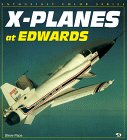 X-Planes at Edwards (Enthusiast Color
Series) by
Steve Pace
X-Planes at Edwards (Enthusiast Color
Series) by
Steve Pace
 Edwards Air Force Base : Open House at the USAF
Flight Test Center 1957-1966 : A Photo Chronicle of
Aircraft Displayed (Schiffer Military History) by Robert D. Archer
Edwards Air Force Base : Open House at the USAF
Flight Test Center 1957-1966 : A Photo Chronicle of
Aircraft Displayed (Schiffer Military History) by Robert D. Archer
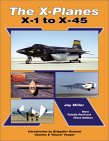 The X-Planes: X-1 to X-45: 3rd Edition
by Jay Miller
The X-Planes: X-1 to X-45: 3rd Edition
by Jay Miller
 Angle of Attack : Harrison Storms and the Race to
the Moon by Mike Gray. The biography of Harrison Storms, who
was instrumental in the development and operation of the X-15.
Angle of Attack : Harrison Storms and the Race to
the Moon by Mike Gray. The biography of Harrison Storms, who
was instrumental in the development and operation of the X-15.
 At the Edge of Space : The X-15 Flight Program
by Milton O. Thompson. The story of test flying the X-15 from the
point of view of the pilot.
At the Edge of Space : The X-15 Flight Program
by Milton O. Thompson. The story of test flying the X-15 from the
point of view of the pilot.
Send a message to Brian.
 Go to home page
of the Goleta Air and Space Museum.
Go to home page
of the Goleta Air and Space Museum.